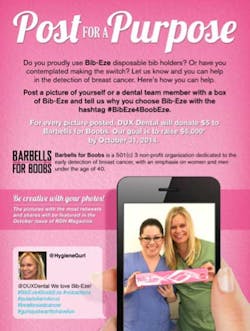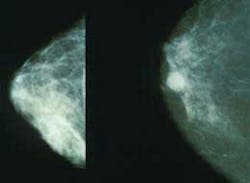Following the theme of Breast Cancer Awareness, here are 14 questions about a potential breast cancer diagnosis that are worth asking your health-care provider.(3)
1. What type of breast cancer do I have? What is the location? Is it infiltrating or invasive, or noninvasive?
2. What is the size of the tumor?
3. Has the cancer spread (metastasized) to the lymph nodes?
4. What is the stage of the breast cancer? The TNM staging system that is the most common one used to describe the stages of breast cancer is the AJCC/TNM. This system takes into account the tumor size and spread (T), whether the cancer has spread to lymph nodes (N), and whether it has spread to distant organs (M, for metastasis). Numbers after the T, N, and M give details about the cancer.(4) This is necessary to determine the type of treatment.
There are many in the dental community who want to raise awareness of breast cancer. Smile Pink is a group of dedicated dental professionals who have come together to increase Breast Cancer Awareness via the dental community.(10) Visit the National Breast Cancer Foundation's site to learn more.(11) Their mission is to help women now by providing help and inspiring hope to those affected by breast cancer through early detection, education, and support services.
Maria Perno Goldie, RDH, MS, is the editorial director of RDH eVillage FOCUS.
References
1. http://bibezeforboobeze.com/
2. https://www.barbellsforboobs.org/
3. http://health.clevelandclinic.org/2014/02/14-questions-about-your-breast-cancer-diagnosis/.
4. http://www.cancer.org/cancer/breastcancer/overviewguide/breast-cancer-overview-staging.
5. http://www.cancer.gov/cancertopics/factsheet/detection/tumor-grade.
6. http://ww5.komen.org/BreastCancer/TumorCharacteristics.html.
7. http://my.clevelandclinic.org/disorders/Breast_Cancer/hic_Breast_Cancer_QandA_Timing_of_Reconstruction.aspx.
8. http://www.cancer.org/cancer/breastcancer/overviewguide/breast-cancer-overview-treating-radiation.
9. http://www.cancer.org/cancer/breastcancer/overviewguide/breast-cancer-overview-treating-clinical-trials.
10. http://www.smilepink.com/.
11. http://www.nationalbreastcancer.org/breast-cancer-awareness-month.










